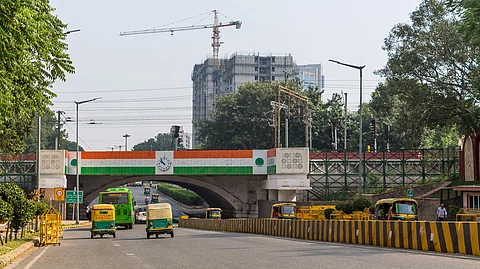

On June 28, 2024, extremely heavy monsoon rains in Delhi submerged the entire national capital. Eleven people died and many underpasses, including the Minto Bridge, were filled with so much water that they had to be closed.
This is not the first time that the Minto Bridge and underpass got flooded. In July 2020, a Delhi Transport Corporation bus sank under the Minto Bridge and a person died due to waterlogging after heavy rainfall.
The recurrence of waterlogging under the Minto Bridge points to the sheer lack of knowledge about the Indian subcontinent’s rainfall patterns by the man who built New Delhi as India’s new capital — the British architect Edwin Lutyens.
Minto is a railway bridge built on Minto Road. It is named after Gilbert Elliot-Murray-Kynynmound, 4th Earl of Minto, who was the viceroy and governor-general of India from 1905 to 1910.
Today, however, the bridge’s name is recorded as Shivaji Bridge in government documents.
It was built in 1933, between the flood plains of the Yamuna river and the Delhi Ridge. The Delhi Ridge is the northern extension of the ancient Aravalli hill range, which is surrounded by urban areas. Lime mortar and cement have been used to build the Minto Railway Bridge.
The bridge connects to the heart of Delhi, Connaught Place (known today as Rajiv Chowk) and the New Delhi Railway Station. It is now known less for of its beautiful arc-shaped civil engineering and more for waterlogging; a location where not only vehicles with powerful engines go under water during the rainy season, but there is a possibility of people drowning. The bridge thus has become lethal.
The road beneath the 90-year-old bridge is shaped like a bowl, which gets heavily waterlogged during the monsoon. Many changes have been made to avoid the problem of waterlogging under the bridge. For instance, the path has been widened. Also, powerful motor pumps have been installed so that the water can be drained out as soon as it collects under the bridge. However, all these measures have proved unsuccessful so far.
Minto Bridge was built by the team of Edwin Lutyens, the builder of New Delhi, during the colonial period. It is considered a classic example of colonial British architecture in the subcontinent.
Lutyens, one of the best architects of his time, kept in mind the beauty of this bridge in New Delhi. But he forgot that there is a lot of difference in the rainfall of Europe and India.
Bundon ki Sanskriti (the Hindi translation of Dying Wisdom), published by Delhi-based non-profit Centre for Science and Environment, quotes the late prominent meteorologist PR Pisharoti regarding the variation in rainfall, “The nature of rainfall in India is completely different from that in Europe. And the engineers who came from Europe during colonial rule did not understand the same mistake. Even now, projects being planned and implemented do not match the native environment.”
Pisharoti further explains: “Unlike Europe, it does not rain throughout the year in India. Rain falls mainly in four months of the year. Even during these days, it does not rain every day. In most areas of the country, most of the rain falls within 50 days. And during these days, it rains in torrents. In most parts of the country, it falls within 100 hours.”
In Bundon ki Sanskriti, a claim has been made quoting Pisharoti’s experience in this regard that the average centimetres (cm) of rain falling at any place often falls in the same number of hours.
For example, Delhi receives 80 cm rainfall and it rains here within 80 hours. Not only this, according to Pisharoti, half of the water of the year falls within only one-fifth of the rainy hours.
Thus, if an average rainfall of 80 cm occurs in a city, then 40 cm of water falls in just 16 hours. Whereas if we look at the entire country, half of the rainfall falls within just 20 hours.
According to the India Meteorological Department, 229 millimetres (mm) of rainfall was recorded at Safdarjung station till 8:30 am on June 28, 2024, which was the second highest rainfall in the month of June since 1936. These few hours of rainfall in Delhi, which receives an average annual rainfall of 800 mm, shows the nature of the Indian monsoon — how a lot of rainfall can occur in a matter of a few hours.
Perhaps architect Lutyens could not understand the fact of torrential rains in India.
According to Pisharoti, “Edward Lutyens, who planned to settle the city of Delhi, could not even understand the nature of the rainfall that occurs here. The road connecting New Delhi and Old Delhi passes under the Minto Bridge, which receives 20 to 30 mm rainfall. It gets filled with water as soon as it rains. Perhaps this famous architect must have thought that 800 mm of rainfall in Delhi would be equivalent to 365 days.”
This shows that due to lack of knowledge of the local environment, not only is a nearly 90- year-old bridge now a ruined specimen, but the blind imitation of engineers is causing even modern underpasses to flood within a few hours of rain.